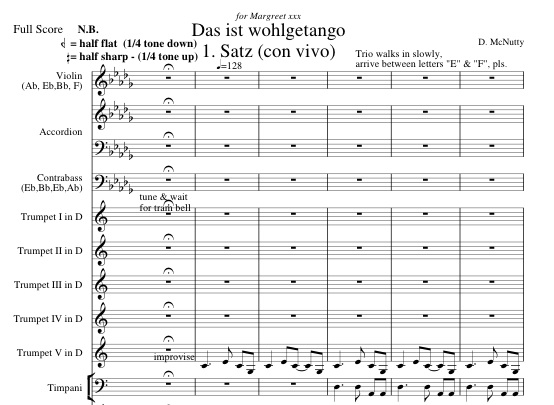HIP hip
April 2011
You only live once, but if you do it right, once is enough.
Mae West
Welcome to a very special occasion: Easter Sunday, De Swaen’s 100th concert in Am-sterdam in the 10-year series and Margreet’s choice. Assuming that you know what Easter and 100th concert mean, Margreet is a founding member and tirelessly manages most of the organisation. She has chosen Bach’s Easter Oratorio BWV 249 and commissioned a new piece to celebrate. Das ist Wohlgetango (Birthday Suite)
is a concerto for the Charivari Trio and Barokensemble De Swaen by the winner of the "instrumental" category in last April’s audience poll, Des McNutty.
Des writes: "Like BWV207, It’s a pun on the double meaning of the word concerto - playing with conflict and concord between the two very-different, opposed-yet-united groups. It was conceived for only one performance, to reflect the transience of a sunset or a good meal. It may contain the odd surprise. Please do not throw anything at the stage. Sorry I can’t be there in the audience; you know Hollywood." (read Des’ programme notes)
Amongst others, Telemann wrote for a combination of folk and "art", or "employed", musicians, so the idea is not radically new, even if the idea of steady employment for performing musicians might seem old-fashioned nowadays. For the Premieres season, De Swaen commissioned five new works from living composers, who were asked to consider various elements of Baroque music in their pieces. These included dance forms, improvisation and folk influences. So what could be more fitting now than to perform with a World Music trio?
The Charivari trio have performed and recorded a variety of World-Music styles over the last 30 years and have enjoyed a few collaborations, including a fantastic CD with Joop van Erven and the Guus Tangelder Bigband, Una Noche. It is a joy to play with such an experienced group. This concert is also a bit of a reunion: Margreet, Anneke, Gerard, Bart and Rob all studied together in Arnhem.
Congratulations to two of today’s (five!) trumpeters, Bruno and Nicolas, who have just won places to study the real natural trumpet with the only conservatoire teacher that plays high-Baroque repertoire on one in public - JF Madeuf at the SCB in Basel.
Because we simply can’t stop ourselves taking our Historically Informed/Inspired Performance (HIP) seriously, the ensemble and choir is bigger than our usual one-voice-per-part (OVPP) setting, as was appropriate for a lot of 18th century Festmusik. This costs even more than usual to stage (there are about 45 performers today, from all over Europe), so please be even more generous than usual after the concert. The recommended minimum donation is 10 Euros but please give more if you can.
Massive thanks must go to Rob Vermeulen for helping us out once again. It’s his choice in June and Lucas’s next month for barokensemble De Swaen’s last two concerts ever.
Be here!
Mike Diprose
April 2011
Des McNutty
Das ist Wohlgetango (Birthday Suite)
Concerto for Charivari Trio and barokensemble De Swaen
D. McNutty, 2011
For Margreet

1. Satz: Con vivo. Innocence, xenophobia, conflict and resolution - this movement is a childish, tribal diva-off, with both groups trying to upstage each other and misbehaving a little whilst finding common ground. The piece starts with the ubiquitous Spui tram bell, which prompts the tuning ritual. There is some chronological progression of homages, starting with a pastiche of a 16th-century Bendenelli toccata with five trumpets and timpani.
2. Satz: Tempo di ostinato, returns by popular demand, slightly reset from Swaen Suite (2009), based on Weil du vom Tod erstanden bist, Luther, (1524), (used in BWV 95).
3. Satz: Verschollen
4 Satz: Wysterioso inspired by watching the little adventures of a magical bumblebee in a climbing plant. De Swaen is an anagram of "need saw".
5. Satz: Giocoso. Balkan-samba mash-up, or Cuban tzigane. With Geigenkrieg.
There are some unusual things about this piece: The different performing pitches of the two groups, means that in places, instruments play in seven different keys at the same time; use of the "natural" scale; a string ensemble in repieno; muted trumpets (transposing them further); a special part for the conductor; post-futurist clangeresque; cantus caesus; audience participation and some surprise "doublings". The chorale tune upon which this work is based is by Samuel Rodigast (1674) and appears irresistibly in BWV 100.
Everyone that makes the De Swaen experience what it is, audience and all, is included in this work, along with references to every piece that De Swaen has performed over the last ten years; although in some cases, only one note and mostly Ds. See how many you can spot! Therefore, apart from the improvisation, there are hardly any original notes in this piece; but it may be the first time they have been arranged in this order. Pedants: relax and rejoice in the accuracy of the performance! Whatever happens in the next 14 minutes or so is absolutely the composer’s intention, waltz and all.